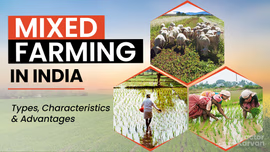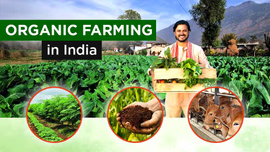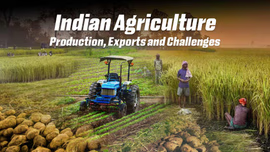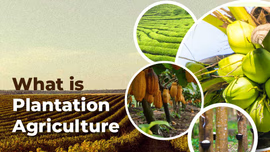Top 10 Methods of Composting Waste in India

Table of Contents
Introduction
Indian agriculture has one of the best agricultural models that effortlessly amalgamates science and philosophy for the production of food along with the nourishment of soil. Modernization and intensification of agriculture is increasing to ensure the food security of our overpopulated country. However, this also has led to the increase in the quantity of crop residue. Inappropriate management of the crop residue or burning eventually affected the soil and human health. Therefore, several technologies have been introduced to convert these crop residues into organic fertilizers mainly via composting.
Composting is the natural process of decomposing organic matter like food scraps, leaves, animal wastes, etc. by microorganisms in controlled conditions. This natural and eco-friendly process forms a nutrient-rich compost which can be added to soil for improved plant growth. Waste management is a big challenge in India. Composting helps divert organic waste from landfills and thus mitigates environmental pollution. Let’s look at the top 10 methods of composting.
What are the Top 10 Methods of Composting Waste?
Composting of waste is an essential aspect of organic farming in India. This effective and sustainable method manages organic materials that are usually discarded. It not only helps in waste reduction but also facilitates soil enrichment.
Various composting methods are used worldwide. Each one has its own benefits and suitability for different conditions. The following are the different types of composting waste:
Traditional Composting
Traditional composting of waste is among the most simple and cost-effective composting methods. Thus, it is most suitable for households, community gardens and small-scale farming. Organic waste materials such as kitchen scraps and dry leaves are layered in a composting bin or pile. Turning or mixing is done periodically to promote aeration and decomposition.
Microorganisms break down the organic matter into compost over time. This bio compost can be effectively used as a natural fertilizer.
Vermicomposting
Vermicomposting uses earthworms to accelerate the decomposition process. Organic waste materials and bedding materials, such as dry leaves, are placed in a container or vermicomposting bin. Organic matter is consumed by the earthworms, and the organic manure of earthworms (castings) acts as a nutrient-rich fertilizer.
The types of vermicomposting include the bed method and pit method. Vermicomposting is highly efficient in producing high-quality compost. Also, it is perfect for household and commercial-scale composting.
Aerated Static Pile Composting
Aerated static pile composting involves the creation of a large compost pile that is aerated with the help of a perforated pipe system. A large heap is formed by mixing the organic waste materials. The perforated pipes are inserted into the pile to provide oxygen.
Proper aeration and controlling temperature are maintained via a blower system. This process of composting waste promotes faster decomposition and is suitable for large-scale composting, such as municipal solid waste composting facilities.
In vessel Composting
In vessel composting is a controlled composting method that is conducted inside enclosed containers or vessels. The organic waste materials are put into the vessels, where temperature, moisture and aeration are carefully controlled.
Composting of waste occurs under controlled conditions. It allows for faster decomposition and odour control. In-vessel composting is fit for urban areas with space constraints and can handle a wide range of organic waste, including food waste and garden trimmings.
Windrow Composting
This composting method involves the creation of long, narrow piles or windrows of organic waste. With the help of machinery or equipment, waste materials are turned periodically. It ensures proper aeration and decomposition.
The windrow composting process is commonly adopted in large-scale composting, such as agricultural waste or livestock manure composting. It demands more space and careful monitoring of moisture content, turning frequency and pile dimensions.
Bokashi Composting
Bokashi composting originated in Japan as a fermentation-based composting method. It involves using a special composting mix or inoculant that contains effective microorganisms (EM).
Organic waste is put in airtight containers, and the EM inoculant is added. The waste undergoes fermentation, which breaks down the organic matter. Bokashi composting is best for households and urban environments due to its compact size, quick fermentation process and odour control.
Pit Composting
A pit or trench is dug in the ground. Then, organic waste materials are added to the pit in layers along with a bulking agent like dry leaves or straw. The pit is covered with soil or a compost cover to promote decomposition and prevent odour. With time, the organic waste breaks into compost, enriching the soil with nutrients.
Pit composting is a sustainable way to manage organic waste in areas with limited resources. It is a simple, low-cost method suitable for rural areas and small-scale farming as it requires minimal equipment.
Anaerobic Digestion
Anaerobic digestion is a composting method involving the breakdown of organic waste without oxygen. The waste is placed in an airtight container called a digester. Anaerobic bacteria break down the waste and produce biogas, a mixture of methane and carbon dioxide.
The biogas can be captured and used as a renewable energy source. The remaining sludge can be further composted to produce nutrient-rich fertilizer. Anaerobic digestion is recommended for large-scale waste management, like municipal wastewater treatment plants or biogas production facilities.
Community Composting
Community composting involves the collective effort of a community or neighborhood to compost organic waste. This method can take various forms, including shared composting bins, community gardens with composting facilities or cooperative composting initiatives.
Community composting promotes waste reduction, fosters community engagement, and provides a valuable resource in the form of compost for community gardens or local agriculture.
Industrial Composting
Industrial composting is among the popular bio compost making methods. It includes large-scale composting operations that manage large volumes of organic waste, like agricultural residues, food processing or municipal solid waste.
Commercial composting methods have facilities with specialized equipment and technologies to facilitate efficient composting. Examples include shredders, windrow turners and temperature control systems. Industrial composting has an important role in waste management and sustainable agriculture.
Other popular composting techniques include ring compost and pipe compost. Composting provides a helpful method to recycle food and other organic waste. It offers a variety of environmental benefits, like improved soil health and reduced greenhouse gas emissions. You can easily choose among the discussed composting methods based on your space and needs.
Frequently Asked Questions On Top 10 Methods of Composting Waste in India
1. What is composting of waste?
Composting means recycling waste and organic matter into a nutrient-rich manure.
2. What types of waste can be composted?
A variety of waste materials can be composted, including food scraps, dry leaves, plant stalks, and fruit and vegetable scraps.
3. How to make compost out of food waste?
Dig a pit in an open space and bury the food waste in it. Cover it with soil and mulch and leave it to decompose.
4. How to avoid smelly compost of food waste?
To avoid smell, you must ensure balanced moisture, add dry materials and avoid oily, dairy or meat products.
5. How to compost biodegradable waste from the kitchen?
Set up a compost bin or dig a compost pit. Put green (nitrogen-rich) and brown (carbon-rich) materials in it. Leave it for 3 weeks to 3 months.
6. How to increase the produce of compost from food waste?
Certain earthworm species can be added to improve the composting process.
7. Is composting a process of waste generation?
No, composting is not a process of waste generation but a method of waste management.
8. Is oxygen used in composting of waste?
Yes, oxygen is used for composting organic waste.
9. What is the end product of composting of solid waste?
Compost, or organic manure, is the end product of composting solid waste.
10. What is mechanical composting of solid waste?
A mechanical composting system has one or more digesters that have rotating vanes for mixing and aerating the waste.


Related Blogs












